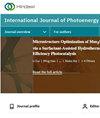Energy Management System for Smart Grid in the Presence of Energy Storage and Photovoltaic Systems
IF 2.1
4区 工程技术
Q3 CHEMISTRY, PHYSICAL
引用次数: 0
Abstract
Today, the desire to use renewable energy as a source of clean and available energy in the grid has increased. Due to the unpredictable behavior of renewable resources, it is necessary to use energy storage resources in the microgrid structure. The power generation source and the storage source in microgrids should be selected in such a way that it has the ability to respond to the maximum demand in the state connected to the grid and operate independently. In this article, the optimal capacity and economic performance of a microgrid based on photovoltaic and battery system have been investigated. In this way, first, using the iterative optimization method, the optimal microgrid capacity has been obtained. Then, the dynamic planning method has been used for optimal microgrid energy management. The simulation results show the accuracy and efficiency of the proposed solutions. The proposed controller, while automatically and dynamically adapting to the solar cell output changes, is capable of responding to external requests, such as price signals or satisfying power system constraints or operator requests. In addition, the results indicate that by using the proposed energy management system, the microgrid system can regain stability during one to two cycles, during the occurrence of PV system radiation changes as well as ESS charge changes. And also, according to the ESS charge changes, the voltage changes should be within the defined permissible range between 0.95 and 1.05 pu, which is the result of the unique efficiency of the proposed energy management system.储能和光伏系统存在下的智能电网能量管理系统
如今,在电网中使用可再生能源作为清洁和可用能源的愿望有所增加。由于可再生资源的不可预测行为,有必要在微网结构中使用储能资源。微电网的发电源和储能源的选择应使其在并网状态下具有响应最大需求的能力并独立运行。本文研究了基于光伏和电池系统的微电网的最优容量和经济性能。这样,首先,采用迭代优化方法,得到最优微网容量。然后,将动态规划方法应用于微网能量优化管理。仿真结果表明了所提方法的准确性和有效性。所提出的控制器在自动动态适应太阳能电池输出变化的同时,能够响应外部要求,如价格信号或满足电力系统约束或操作员的要求。此外,研究结果表明,采用所提出的能量管理系统,在光伏系统辐射变化和ESS电荷变化期间,微网系统可以在1 ~ 2个周期内恢复稳定。此外,根据ESS电荷变化,电压变化应在规定的允许范围内0.95 ~ 1.05 pu,这是所提出的能量管理系统的独特效率的结果。
本文章由计算机程序翻译,如有差异,请以英文原文为准。
求助全文
约1分钟内获得全文
求助全文
来源期刊
CiteScore
6.00
自引率
3.10%
发文量
128
审稿时长
3.6 months
期刊介绍:
International Journal of Photoenergy is a peer-reviewed, open access journal that publishes original research articles as well as review articles in all areas of photoenergy. The journal consolidates research activities in photochemistry and solar energy utilization into a single and unique forum for discussing and sharing knowledge.
The journal covers the following topics and applications:
- Photocatalysis
- Photostability and Toxicity of Drugs and UV-Photoprotection
- Solar Energy
- Artificial Light Harvesting Systems
- Photomedicine
- Photo Nanosystems
- Nano Tools for Solar Energy and Photochemistry
- Solar Chemistry
- Photochromism
- Organic Light-Emitting Diodes
- PV Systems
- Nano Structured Solar Cells

 求助内容:
求助内容: 应助结果提醒方式:
应助结果提醒方式:


